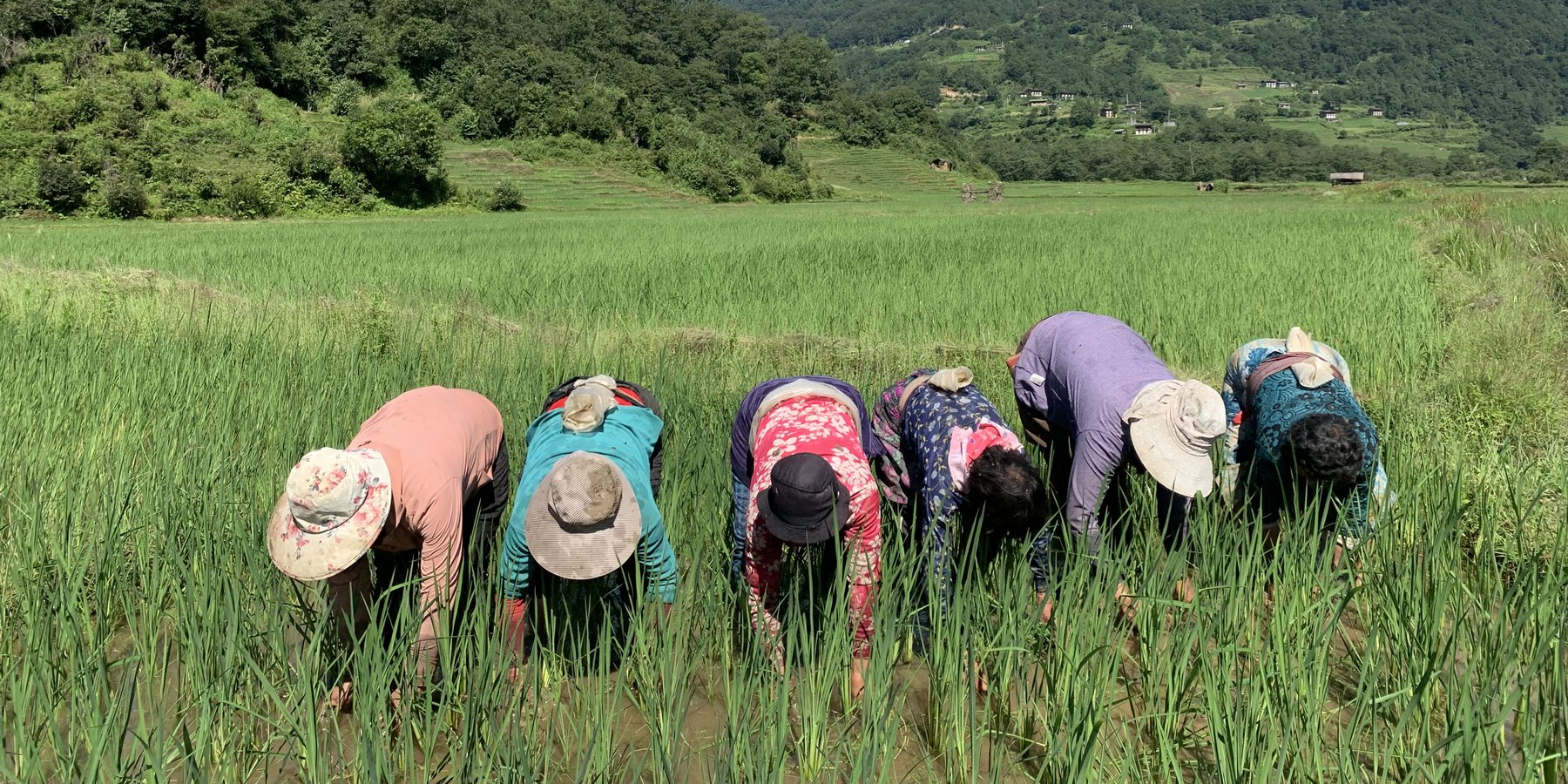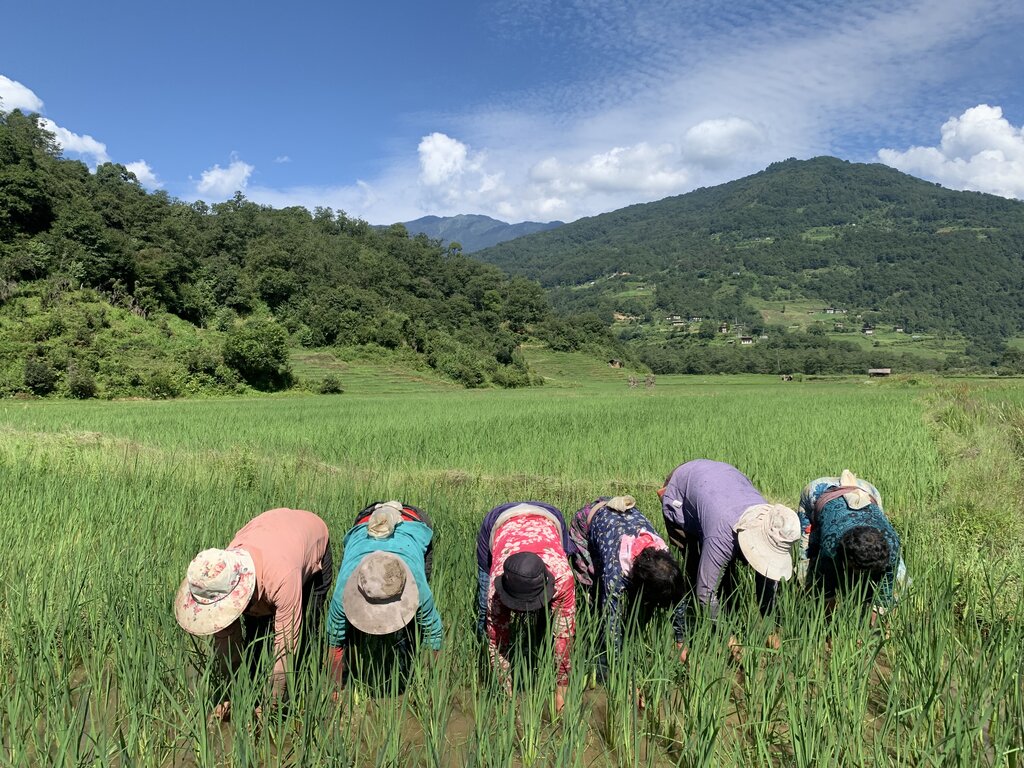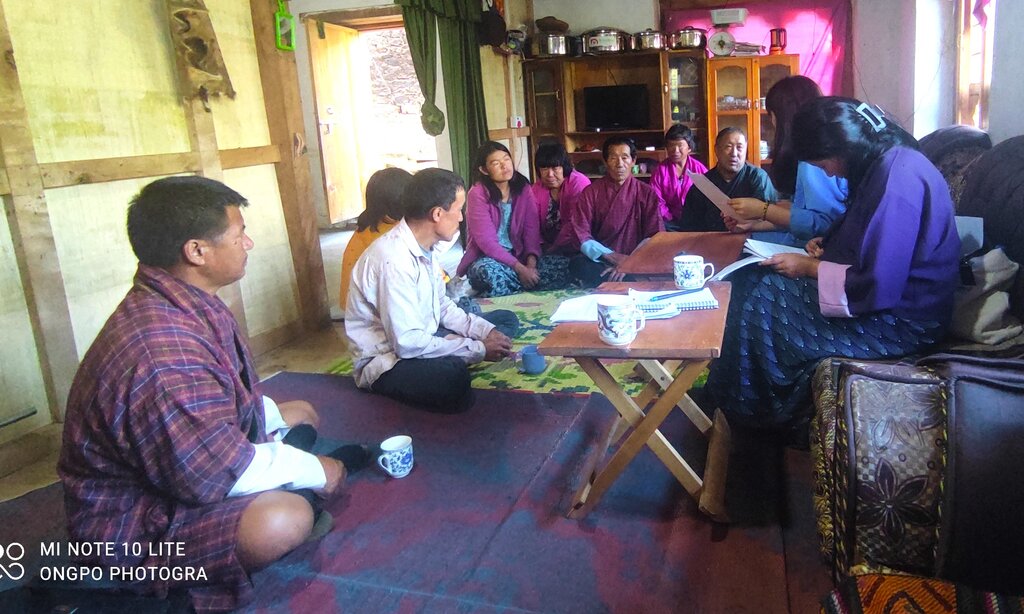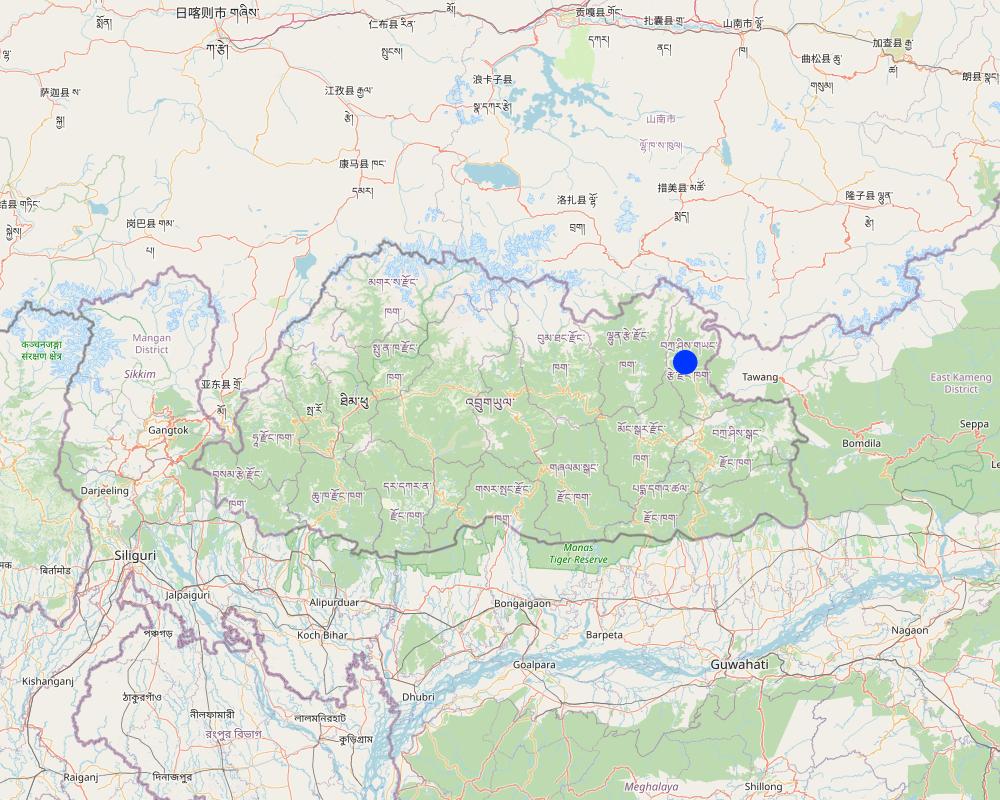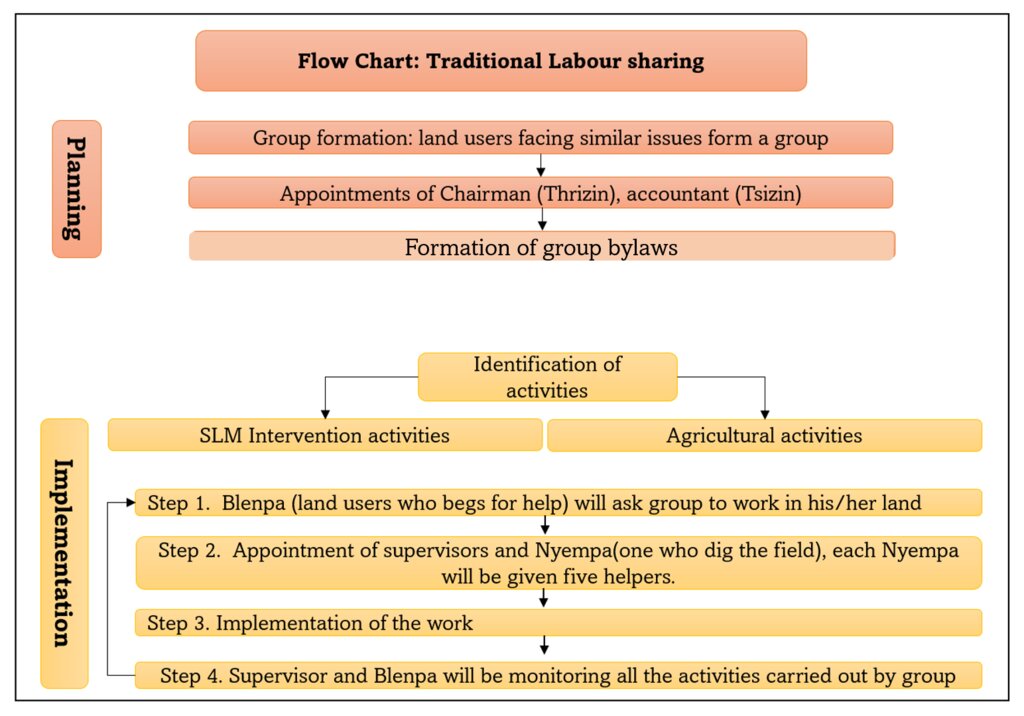Traditional labour sharing for farming [Bután]
- Creación:
- Actualización:
- Compilador: ONGPO LEPCHA
- Editor: Tashi Wangdi
- Revisores: William Critchley, Rima Mekdaschi Studer, Joana Eichenberger
Sanam Zhing La Gi Dhoen Lu Latshab (སོ་ནམ་ཞིང་ལཱ་གི་དོན་ལུ་ལཱ་ཚབ།)
approaches_6894 - Bután
Visualizar secciones
Expandir todo Colapsar todos1. Información general
1.2 Detalles de contacto de las personas de referencia e instituciones involucradas en la evaluación y la documentación del Enfoque
Persona(s) de referencia clave/s
Usuario de la tierra:
Geduula
17324491
Namthurang wog, Betsamaang, Bumdeling, Trashi Yangtse District
Bután
Usuario de la tierra:
Dema Karma
17328742
Namthurang wog, Betsamaang, Bumdeling, Trashi Yangtse District
Bután
Usuario de la tierra:
Pelden Tshering
17371568
Namthurang wog, Betsamaang, Bumdeling, Trashi Yangtse District
Bután
Usuario de la tierra:
Tshering Gonpo
17559260
Namthurang wog, Betsamaang, Bumdeling, Trashi Yangtse District
Bután
Usuario de la tierra:
Wangmo Ugyen
17278903
Namthurang wog, Betsamaang, Bumdeling, Trashi Yangtse District
Bután
Usuario de la tierra:
Karma
17363810
Namthurang wog, Betsamaang, Bumdeling, Trashi Yangtse District
Bután
Usuario de la tierra:
Gurula
17718668
Namthurang wog, Betsamaang, Bumdeling, Trashi Yangtse District
Bután
Usuario de la tierra:
Choden Karma
17781323
Namthurang wog, Betsamaang, Bumdeling, Trashi Yangtse District
Bután
Usuario de la tierra:
Chozom Sither
17743907
Namthurang wog, Betsamaang, Bumdeling, Trashi Yangtse District
Bután
Usuario de la tierra:
Gonpo Tshewang
17705121
Namthurang wog, Betsamaang, Bumdeling, Trashi Yangtse District
Bután
Nombre del proyecto que facilitó la documentación/ evaluación del Enfoque (si fuera relevante)
Strengthening national-level institutional and professional capacities of country Parties towards enhanced UNCCD monitoring and reporting – GEF 7 EA Umbrella II (GEF 7 UNCCD Enabling Activities_Umbrella II)Nombre de la(s) institución(es) que facilitaron la documentación/ evaluación del Enfoque si fuera relevante)
National Soil Services Centre, Department of Agriculture, Ministry of Agriculture & Livestock (NSSC) - Bután1.3 Condiciones referidas al uso de datos documentados mediante WOCAT
¿Cuándo se compilaron los datos (en el campo)?
20/7/2023
El compilador y la/s persona(s) de referencia claves aceptan las condiciones acerca del uso de los datos documentados mediante WOCAT :
Sí
2. Descripción del Enfoque MST
2.1 Breve descripción del Enfoque
In the past, it was difficult for households to complete seasonal farming activities like ploughing, sowing, and transplanting in time. So, land users came together by adopting 'latsab' or labour sharing. This involves pooling land users, who work on a rotational basis on the plots of the different group members. Labour sharing is a very old approach but is still being practiced throughout the country.
2.2 Descripción detallada del Enfoque MST
Descripción detallada del Enfoque MST:
In the past, it was difficult for households to complete seasonal farming activities like ploughing, sowing, and transplanting in time. So, land users came together by adopting 'latsab' or labour sharing. This involves pooling land users, who work on a rotational basis on the plots of the different group members. Labour sharing is a very old approach but is still being practiced throughout the country. In addition, land users also come together for any construction work or other activities related to land management. Labour sharing aims to complete seasonal farming activities more efficiently and on time. The approach also helps economically disadvantaged land users who cannot pay wages to employ. Other co-benefits reported are the improved sense of community and enhanced social cohesion because the exchange of experiences and collaboration builds mutual trust. Working in a group eases hard physical work, such as carrying and breaking large boulders, and is perceived to be much more enjoyable than working alone or in a household setting.
Groups are formed at the village and sub-village levels to enable households to take up labour-intensive SLM activities, such as stone bunding, bench terracing, stone check dam construction, water source protection works, or grass hedgerow development. Labour-sharing involves land users coming together to discuss important agricultural activities to be implemented. They also select the land users where the work should start. When it comes to activities related to SLM intervention, the land users are given initial practical training on the SLM intervention, which starts with hands-on work on the land of a group member, preferably that of a vulnerable household. Labour-sharing groups, therefore, facilitate the inclusion of vulnerable households, especially female-headed and small families, in the implementation of labour-intensive SLM interventions. In addition to technical guidance provided by extension staff, support is given to the group formation process, such as drafting informal by-laws and group management.
Any activities through a labour-sharing approach have to undergo specific stages. Initially, the land users will come together to discuss important agricultural or SLM activities to be carried out in a season. Secondly, they identify a 'Blenpa' who is a land user who requests help on his/ her land. Once in the field before they start any activities a supervisor or 'la pon' is appointed. If work involves heavy digging, a 'Nyempa' (preferably a strong man) is appointed, and he will be assisted by four or five women. The labour-sharing group is formed through common interests among different land users in the community. The group members come together and plan and prepare by-laws. They appoint a chairman or 'Trizin', who is the overall manager of the group. The accountant/treasurer or 'Tsezin' is appointed to take care of the finances. Any conflict between land users is solved within the group.
2.3 Fotos del Enfoque
2.5 País/ región/ lugares donde el Enfoque fue aplicado
País:
Bután
Región/ Estado/ Provincia:
Namthrang wog (sub village), Betsamaang(village), Bumdeling(region), Trashi Yangtse(Provience)
Map
×2.6 Fechas de inicio y conclusión del Enfoque
Si no se conoce el año preciso, indique la fecha aproximada en la que se inició el Enfoque:
hace más de 50 años atrás (tradicional)
Comentarios:
The exact date and year of initiation are not known as this approach has been practiced by their ancestors.
2.7 Tipo de Enfoque
- tradicional/ local
2.8 Propósitos/ objetivos principales del Enfoque
The main aims/objectives of the approach are 1) Labour-sharing to complete seasonal activities faster and on time, 2) To support economically disabled land users who cannot pay for hired workers, and 3) To share resources like water which is important for carrying out farming activities.
2.9 Condiciones que facilitan o impiden la implementación de la/s Tecnología/s aplicadas bajo el Enfoque
normas y valores sociales/ culturales/ religiosos
- facilitan
All land users involved are from same ethnic group. They shared common social, cultural, and religious, norms and values. Implementation of any SLM activities was seen as enabling.
disponibilidad/ acceso a recursos y servicios financieros
- facilitan
Land users were accessible to financial resources and services as most of them are either members of a vegetable group or a Chilli group. As a member, they are privileged to avail loans.
colaboración/ coordinación de actores
- facilitan
The group formation is democratic and the leader selected to regulate the group was selected by land users themselves. Therefore, strong collaboration is observed.
conocimiento de MST, acceso a apoyo técnico
- facilitan
Land users are aware of SLM interventions like terracing, bunding, stone bunding, growing Napier grass, etc. These indicated that they have good knowledge and are accessible to technical support from SLM specialists.
mercados (para comprar insumos, vender productos) y precios
- facilitan
Land users indicated that they have a good market for their produce like chilli and potatoes. They have a group that deals with marketing.
carga de trabajo, disponibilidad de mano de obra
- facilitan
Land users are happy that the current approach of labour-sharing helped them a lot when it comes to workload and labour shortage. Although if there are fewer household members, the approach helps them to carry out important agricultural activities in time.
3. Participación y roles de las partes interesadas involucradas
3.1 Partes interesadas involucradas en el Enfoque y sus roles
- usuarios locales de tierras/ comunidades locales
10 households were involved out of which 6 are females and 4 are male. They are mostly from the age group between 40-60 years old, All of them are married and are economically disabled. All of them belong to the same ethnic group known as
Land users are involved in the planning of by-laws, and implementation of activities, Elected chairman is responsible for the smooth functioning of the group. The accountant takes care of the finances. Any conflict between land users is solved within the group.
- especialistas MST/consejeros agrícolas
Extension agent
He/she is not part of the group but is involved whenever he/she needs assistance from the group. He/she acts as an SLM specialist at the village level.
3.2 Involucramiento de los usuarios locales de tierras/ comunidades locales en las distintas fases del Enfoque
| Involucramiento de los usuarios locales de tierras/ comunidades locales | Especifique quién se involucró y describa las actividades | |
|---|---|---|
| iniciación/ motivación | auto-movilización | The labour-sharing approach was initiated by the ancestors of current land users. Current land users found this approach as an effective way to mitigate labour shortage and resource management and they continue to preserve and practice it. |
| planificación | auto-movilización | Land users are the ones who come together, prepare their by-laws and plan all the activities related to farming or SLM intervention. |
| implementación | auto-movilización | The approach has an elected chairman and accountant who are responsible for the smooth running of the group and finances. Any conflicts that arise between land users are solved within the group. |
| monitoreo y evaluación | auto-movilización | The group is monitored by the chairman. During the time of any activities, they also appoint a supervisor who will monitor the quality of the work performed by the members. |
3.3 Flujograma (si estuviera disponible)
Descripción:
Flow chart created following conversation with the group. There are two important phases, initially planning which includes group formation, and by-law, and the second phase is the implementation phase.
Autor:
Ongpo Lepcha
3.4 La toma de decisiones en la selección de Tecnología(s) MST
Especifique quién decidió la selección de las Tecnología/ Tecnologías a implementarse:
- principalmente usuarios de tierras con el apoyo de especialistas MST
Explique:
The technologies implemented by land users have been decided by land users and upon their request to the government the SLM specialist are sent and technology related training and materials are provided to the group.
4. Apoyo técnico, fortalecimiento institucional y gestión del conocimiento
4.1 Construcción de capacidades / capacitación
¿Se proporcionó la capacitación a usuarios de tierras/ otras partes interesadas?
Sí
Especifique quién fue capacitado:
- usuarios de tierras
Forma de capacitación:
- áreas de demostración
Temas avanzados:
Improved ways to dry Chilli, Nursery bed preparation, electric fencing, Growing Napier grass, Chainlink fencing, Greenhouse construction, etc.,
Comentarios:
The training was provided by extension agents
4.2 Servicio de asesoría
¿Los usuarios de tierras tienen acceso a un servicio de asesoría?
Sí
Describa/ comentarios:
Whenever there is an outbreak of crops or livestock diseases, advisory services are provided by agricultural and livestock officers on do and don't of the issues.
4.3 Fortalecimiento institucional (desarrollo institucional)
¿Se establecieron o fortalecieron instituciones mediante el Enfoque?
- sí, mucho
Especifique el nivel o los niveles en los que se fortalecieron o establecieron las instituciones:
- local
Describa la institución, roles y responsabilidades, miembros, etc.
Within the labour-sharing group, land users also have formed other groups like the Chilli group (focusing on cultivating and marketing chilli), Vegetable group (involved in growing and marketing vegetables other than chilli)
Especifique el tipo de apoyo:
- financiero
- construcción de capacidades/ entrenamiento
- equipo
Proporcione detalles adicionales:
The financial institution provides loans to those land users who are members of the group. Support from the government and external projects targeted to the groups. As a result, members of the group have received training in Chilli drying through the Tarayana Foundation. Members also shared that when they work in groups they also share tools, equipments, machinary, etc., which indirectly reduces the cost.
4.4 Monitoreo y evaluación
¿El monitoreo y la evaluación forman parte del Enfoque?
Sí
Comentarios:
Labour sharing involves working on a rotation basis. The group has a chairman who monitors the overall activities of the group. When it comes to agricultural or SLM intervention activities carried out at individual land user's fields. The supervisor is appointed who monitors and supervises the work.
Si respondió que sí, ¿la documentación se utilizará para monitoreo y evaluación?
No
4.5 Investigación
¿La investigación formó parte del Enfoque?
No
5. Financiamiento y apoyo material externo
5.1 Presupuesto anual para el componente MST del Enfoque
Comentarios (ej. fuentes principales de financiamiento/ donantes principales):
The group is mainly formed by those land users who are economically disabled. They work on a rotation basis so that they don't have to pay for human resources involved in carrying out any agricultural or SLM intervention activities.
5.2 Apoyo financiero/material proporcionado a los usuarios de tierras
¿Los usuarios de tierras recibieron financiamiento/ apoyo material para implementar la Tecnología/ Tecnologías? :
Sí
Si respondió sí, especifique el tipo o los tipos de apoyo, condiciones y proveedor(es) :
Electric fencing: The materials were supported by the government.
Chilli dryer:
5.3 Subsidios para insumos específicos (incluyendo mano de obra)
- equipo
| Especifique qué insumos se subsidiaron | En qué grado | Especifique los subsidios |
|---|---|---|
| Chilli Dryer | totalmente financiado | They received one dryer from the Women's Division under the National Commission for Women and Children (NCWC). |
- construcción
| Especifique qué insumos se subsidiaron | En qué grado | Especifique los subsidios |
|---|---|---|
| Electric fencing | totalmente financiado | All the materials required for electric fencing were provided by the Bhutan government. |
- infraestructura
- otro
| Otro (especifique) | En qué grado | Especifique los subsidios |
|---|---|---|
| Green house | parcialmente financiado | The total cost for greenhouse materials was shared between individual land user and the government. 30% of the total cost is borne by land users and 70% by the government. |
Si la mano de obra de usuarios de tierras fue un insumo sustancial, ¿fue:
- recompensado con otro tipo de apoyo material?
Comentarios:
All materials required were supplied by the government for free. Land users were involved in construction/installation.
5.4 Crédito
¿Se proporcionó crédito bajo el Enfoque para actividades MST?
No
5.5 Otros incentivos o instrumentos
¿Se usaron otros incentivos o instrumentos para promover la implementación de Tecnologías MST?
Sí
Si fuera el caso, especifique :
The group also received a cake-making machine. However, this was shared among different groups from other places.
6. Análisis de impacto y comentarios de conclusión
6.1 Impactos del Enfoque
¿El Enfoque empoderó a los usuarios locales de tierras, mejoró el involucramiento de las partes interesadas?
- No
- Sí, un poco
- Sí, moderadamente
- Sí, mucho
Yes, the approach has empowered local land users. Gender equality is maintained and Chairmanship is done on a rotation basis. The work done by the group is supported by government and other external projects.
¿El Enfoque ayudó a los usuarios de tierras a implementar y mantener Tecnologías MST?
- No
- Sí, un poco
- Sí, moderadamente
- Sí, mucho
The group is basically focused on agricultural activities and to protect their crop from wildlife they have installed electric fencing. They also rear dairy as a source of manure to improve the fertility of the soil.
¿El Enfoque mejoró el conocimiento y capacidades de los usuarios para implementar MST?
- No
- Sí, un poco
- Sí, moderadamente
- Sí, mucho
Government and external support is directed to the group because it is quite cheaper than providing to individual land users. Any kind of capacity development related to agricultural activities or SLM intervention is given to the group. Group members also shared that they received training in various fields of SLM like stone bunding, Terracing, Electric fencing, greenhouse construction, and improved dairy shed construction.
¿El Enfoque mitigó conflictos?
- No
- Sí, un poco
- Sí, moderadamente
- Sí, mucho
Establishment of the electric fencing solved human-wildlife conflicts. Irrigation water used to be an important issue for conflict in the past. However, group formation has helped the community improve their irrigation by improving source and also scheduling irrigation timing among the members.
¿El Enfoque empoderó a grupos en desventaja social y económica?
- No
- Sí, un poco
- Sí, moderadamente
- Sí, mucho
The group consists of members who are economically disabled. The group has helped them to sustain their livelihood as any agricultural activities are carried out in time. The members also don't have to pay for labours which otherwise is very expensive. Working together also builds a sense of belongingness and closeness among the members.
¿El Enfoque mejoró el acceso a los mercados?
- No
- Sí, un poco
- Sí, moderadamente
- Sí, mucho
The members of the Labour-sharing group are also members of other groups like the Chilli and Vegetable group. This has helped them to market their produce.
6.2 Motivación principal del usuario de la tierra para implementar MST
- producción incrementada
Every agricultural activity carried out by the group is monitored thus improving the conditions in which a crop grows, thus increasing production.
- incremento de la renta(bilidad), proporción mejorada de costo-beneficio
Members of the group work on a rotation basis thus reducing production costs and increasing the cost-benefit ratio.
- reducción de la degradación de la tierra
Agricultural activities are done manually thus reducing land degradation.
- reducción del riesgo de desastres naturales
Agricultural activities are seasonal and every activity has to be done in time. Labor-sharing groups helped members to complete these activities in time thus reducing the risk of disaster.
- carga de trabajo reducida
Group members come together and work for a common goal thus reducing workload.
- mitigación de conflicto
Member shared that conflict that arises due to irrigation water is no more.
6.3 Sostenibilidad de las actividades del Enfoque
¿Pueden los usuarios de tierras sostener lo que se implementó mediante el Enfoque (sin apoyo externo)?
- incierto
Si respondió no o incierto, especifique y comente:
The approach was there in the past when external support was not there. It is continuing today, but it is uncertain whether this approach will survive in the future with changing climate and improving the lifestyle of every farmer.
6.4 Fortalezas/ ventajas del Enfoque
| Fuerzas/ ventajas/ oportunidades desde la perspectiva del usuario de la tierra |
|---|
| The approach allows members to enhance social cohesion and community sense. They come together for any kind of work, thus tackling the main issue of labour shortage and easing hard physical work. |
| Agricultural activities like ploughing, tilling, sowing, transplanting, weeding, watering, and harvesting, have to be completed on time. The approach allows every member to complete these activities on time avoiding crop failure and enhancing crop production. |
| The approach includes all vulnerable groups giving them opportunities to share their problems and supporting them through labour-sharing to carry out important agricultural activities for crop production. |
| Fuerzas/ ventajas/ oportunidades desde la perspectiva del compilador o de otra persona de referencia clave |
|---|
| The approach demands equal participation from all household members. Thus giving training on any SLM intervention activities by SLM experts becomes very easy. It is also easy to communicate to the group for dissemination of any information. |
| The approach helps the economically disabled members to sustain their livelihood. This is because labour-sharing cut many of the costs involved in crop production or SLM intervention activities increasing the cost-benefit ratio. |
6.5 Debilidades/ desventajas del Enfoque y formas de sobreponerse a ellos
| Debilidades/ desventajas/ riesgos desde la perspectiva del usuario de la tierra | ¿Cómo sobreponerse a ellas? |
|---|---|
| Marketing of agricultural produce: There are many other groups at the village and sub-district level. They compete to capture the local market which is always saturated with supply. Exploring the market at the domestic and international levels is very expensive for the majority of the group. | The government takes some initiative to explore the market for these groups or give them some incentives to do marketing like marketing van. |
| Debilidades/ desventajas/ riesgos desde la perspectiva del compilador o de otra persona de referencia clave | ¿Cómo sobreponerse a ellas? |
|---|---|
| The sustainability of the group: Most of the members are between the age group of 40-70. The young generation is not interested in agriculture and in the future, there are chances that this kind of group may die. | The government must take some initiative to make our young generation like Agriculture by bringing new technologies that will ease hard human labour. |
7. Referencias y vínculos
7.1 Métodos/ fuentes de información
- visitas de campo, encuestas de campo
Three sites were visited to see the group working.
- entrevistas con usuarios de tierras
10 land users representing 10 households were interviewed.
- compilación de informes y otra documentación existente
5
7.2 Referencias a publicaciones disponibles
Título, autor, año, ISBN:
BHUCAT (Bhutan catalogue of soil and water conservation approaches and technologies):Best practices and guidelines from Bhutan for sustainable land managements on steep to very steep slopes, National Soil Service Center, Department of Agriculture, Ministry of Agriculture and Forest 2012,
¿Dónde se halla disponible? ¿Costo?
A copy of a book was provided by National Soil Service Center, Simtokha: Bhutan for Free.
Título, autor, año, ISBN:
2021 Labour force survey report Bhutan, National statistics Bureau, 2021, ISBN 978-99936-28-93-4
¿Dónde se halla disponible? ¿Costo?
available online for free. https://www.nsb.gov.bt/wp-content/uploads/dlm_uploads/2022/04/LFS-2021-web.pdf
7.3 Vínculos a la información relevante disponible en línea
Título/ descripción:
SLM Labour-sharing group Bhutan
URL:
https://qcat.wocat.net/wocat/approaches/view/approaches_2491/
Título/ descripción:
Sharing labour to implement contour bunding in Nepal
URL:
https://qcat.wocat.net/wocat/approaches/view/approaches_2604/
Título/ descripción:
Organic agriculture, Labour exchange, and social networks: a case study of smallholder farming in Bhutan
URL:
https://link.springer.com/article/10.1007/s13165-022-00416-z
Vínculos y módulos
Expandir todo Colapsar todosVínculos
No hay vínculos
Módulos
No se hallaron módulos


